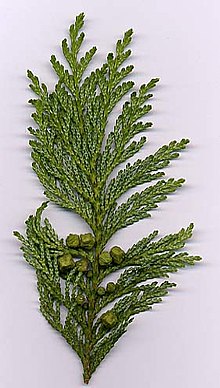| Chamaecyparis | |
|---|---|

| |
| Chamaecyparis pisifera foliage and cones | |
| Scientific classification | |
| Kingdom: | Plantae |
| Clade: | Tracheophytes |
| Clade: | Gymnospermae |
| Division: | Pinophyta |
| Class: | Pinopsida |
| Order: | Cupressales |
| Family: | Cupressaceae |
| Subfamily: | Cupressoideae |
| Genus: | Chamaecyparis Spach |
| Type species | |
| Chamaecyparis sphaeroidea (Spreng.) Spach
| |
| Synonyms[1] | |
| |
Chamaecyparis, common names cypress or false cypress (to distinguish it from related cypresses), is a genus of conifers in the cypress family Cupressaceae, native to eastern Asia (Japan and Taiwan) and to the western and eastern margins of the United States.[1] The name is derived from the Greek khamai (χαμαί), meaning "on the earth", and kuparissos (κυπάρισσος) for "cypress".[2]
They are medium-sized to large evergreen trees growing from 20–70 m (66–230 ft) tall, with foliage in flat sprays. The leaves are of two types, needle-like juvenile leaves on young seedlings up to a year old, and scale-like adult leaves. The cones are globose to oval, with 8-14 scales arranged in opposite decussate pairs; each scale bears 2-4 small seeds.
- ^ a b "Chamaecyparis". World Checklist of Selected Plant Families (WCSP). Royal Botanic Gardens, Kew.
- ^ "Chamaecyparis obtusa - Plant Finder". www.missouribotanicalgarden.org. Retrieved 2021-02-18.